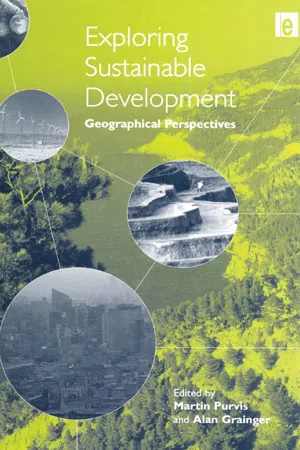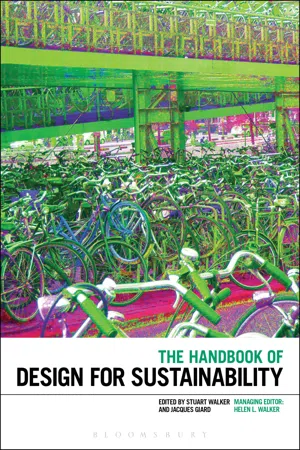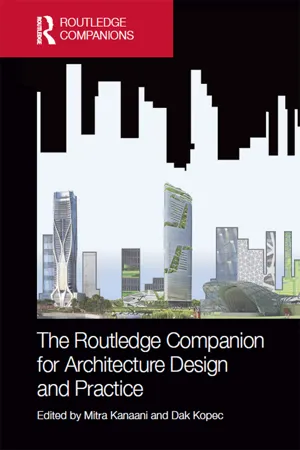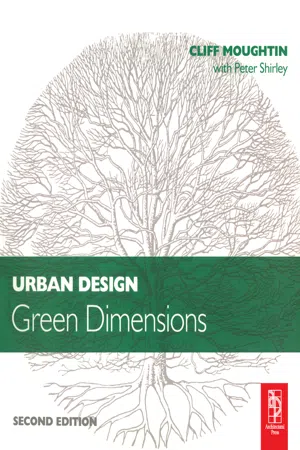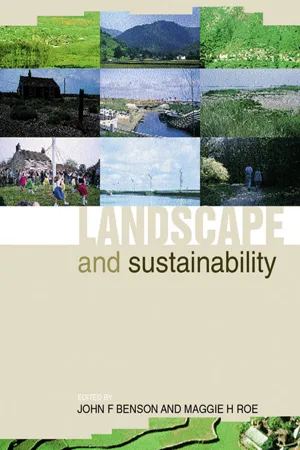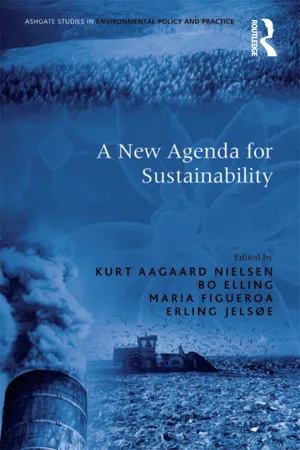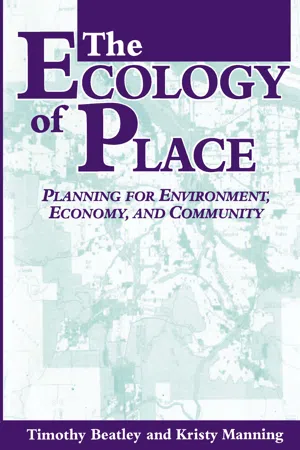Geography
Sustainable Design
Sustainable design refers to the practice of creating products, buildings, and environments that minimize their impact on the natural world and promote ecological balance. It involves considering the long-term environmental, social, and economic consequences of design decisions, and often incorporates principles such as energy efficiency, use of renewable materials, and waste reduction.
Written by Perlego with AI-assistance
Related key terms
12 Key excerpts on "Sustainable Design"
- eBook - ePub
Exploring Sustainable Development
Geographical Perspectives
- Martin Purvis, Alan Grainger(Authors)
- 2013(Publication Date)
- Routledge(Publisher)
The chapter begins by comparing geography’s long-standing interest in both society and nature, and the links that unite them, with the new agenda of sustainable development. This is followed by a brief review of the attention given to sustainable development in the geographical literature, and to the themes of place and space in discussions of sustainable development. The chapter then moves on to consider the potential for applying geographical skills in planning for more sustainable development. Arguably more important, however, is a greater geographical contribution to critical reviews of current thinking about sustainable development, both in practice and in theory.A Case for Geography
Sustainable development in disciplinary perspective
The concept of sustainable development is innovative and distinctive in pointing to the need for simultaneous attention to maintaining economic growth, meeting social needs and conserving environmental quality. This broad and challenging agenda requires that the exploration of sustainable development as theory and practice is grounded in a profound understanding of social, economic and environmental systems. It will necessarily draw upon the input and insights of a wide range of academics, and also of many others, including politicians, planners, development workers, business managers, farmers and consumers. The emphasis placed here on thinking geographically should not, therefore, be misinterpreted. What follows is not a claim of perfect knowledge or a bid for intellectual hegemony. Rather, our case is that geography can make a valuable and distinctive contribution to wider debates about sustainable development.Although geography – like sustainable development – is often seen as resisting unambiguous definition, three themes may be taken to constitute its core. The first is the study of relationships between humanity and the environment. The second is the exploration of the distinct and differing characters of particular places. And, thirdly, geography is concerned with the documentation and analysis of the spatial patterning of phenomena across the surface of the Earth. The variety of studies embraced by these themes, and the potential for tension between different approaches, have sometimes been regarded as marks of disciplinary weakness. Taken together, however, the different facets of geographical study have the power to advance our understanding of the world in important and distinctive ways (see Massey, 2001). In part, this reflects geography’s transcendence of the conventional intellectual divide between the social and natural sciences. An important element of geography’s purpose is to explore the ways in which specific environmental contexts influence human society, and the impact of human actions on the form of the landscape, environmental quality and biodiversity. It follows that geography does not define itself as the exclusive study of a single category of phenomena, but as a discipline concerned with connections, associations and distributions. Thinking geographically can, therefore, encourage a breadth of vision and capacity for synthesis that seem particularly appropriate to the study of sustainable development (on the need for this holistic perspective see Belsky, 2002; Liverman, 1999; Redclift, 1998). More than this, however, there are clear echoes in the contemporary agenda of sustainable development of long-standing geographical concerns with documenting and improving the state of the world. - eBook - ePub
- Stuart Walker, Stuart Walker, Jacques Giard, Helen Walker(Authors)
- 2013(Publication Date)
- Bloomsbury Academic(Publisher)
4Developing Theories for Sustainable Design
DENNIS P. DOORDAN
INTRODUCTION
Calculate, conserve, compensate; reduce, reuse, recycle; environment, economy, people: these are some of the now familiar mantras of Sustainable Design. They are the pithy distillations of efforts to rethink the terms of design practice in light of contemporary environmental concerns. The quest for design practices and products that satisfy needs and sustain culture is not new. In his first-century B.C.E. treatise De Architettura, the Roman architect Vitruvius advises architects to select sites for new towns that will ensure the healthfulness of the future city. He wrote, “I cannot too strongly insist upon the need to return to the method of old times” (1914, p. 20). He went on to argue that new towns should be sited near dependable supplies of fresh water and fertile land able to support the needs of the community. In the design of houses, Vitruvius maintained, architects should take into consideration location and climatic factors such as prevailing winds, solar orientation, and seasonal variations. In this, one of the earliest surviving articulations of what I will label the good-sense wisdom tradition in the planning of human settlements, the architect is an astute observer of locale and as knowledgeable about topography and climate as he is about geometry and proportion. Two thousand years later, in Operating Manual for Spaceship Earth, Buckminster Fuller offered a strikingly different description of the skill set required by a designer: “We will now tackle our present world problems with a family of powerful thought tools: topology, geodesics, synergetics, general systems theory, and the computer’s operational bitting - eBook - ePub
The Routledge Companion for Architecture Design and Practice
Established and Emerging Trends
- Mitra Kanaani, Dak Kopec(Authors)
- 2015(Publication Date)
- Routledge(Publisher)
Part III Architectural Design and Ecological SustainabilityThis part focuses on design for the projection of livable built environments and the requisite knowledge and understanding of ecological sustainability for preserving the planet Earth and its residents. It expands on the relevance of architectural design with a diverse range of meanings of ecological manifestations from the natural and social sciences, extending into the design process as integrative systems thinking. This part looks at Sustainable Design as a meaningful approach toward harmonizing various interrelated flows of forces between the building and its natural environment.Passage contains an image 12 Situating Meanings of Sustainability Within the Architectural Discourse Meredith Sattler
Figure 12.1Hand-held Hasselblad photograph of Earth from Apollo 17. Courtesy of NASA. Image AS17-148-22727On December 7, 1972, as the crew of Apollo 17 left Earth’s orbit for the moon, they took the first ever photograph of the entire planet. In the instant the camera shutter was released, a new holistic paradigm was unleashed, manifest in the image of Earth as one continuous sphere, undivided by boundaries, political or otherwise. It took the Apollo 17 crew a short five hours and six minutes to arrive at this vantage point, but it has proven a lengthier and less calculated journey for those on Earth to unpack the meaning of this image, and ultimately begin to address its implications in terms of environment, equity, and economy.Sustainability implies continuity, by definition. It requires an extended (holistic) view of space and time in order to comprehend, and ultimately facilitate, relationships and feedbacks between seemingly disparate, yet operationally continuous environmental conditions and circumstances. Humans maintain a somewhat complicated relationship with continuity and change. We cultivate changes we value or desire, but are generally risk-averse, preferring slow steady change or no change at all, to general uncertainty or sudden, unanticipated change. Likewise the built environment, which is predominantly static in nature, is particularly demanding of stable conditions. So sustainability, at its core, becomes an exercise in mitigating and managing change, typically slowing and steadying its pace. - Michael Redclift, Delyse Springett(Authors)
- 2015(Publication Date)
- Routledge(Publisher)
The tasks of design students usually include idea generation, concept development, strategic design, project planning, and project management. Besides applying the methods available, students should become familiar with the area of Sustainable Design thinking. As long as integrated models for Sustainable Design are still few (Wigum 2004 ; Morelli, 2007 ; Hussain 2011), theories and methods from other disciplines have to be utilized as well (see Figure 10.5). The future of design curricula is to graduate reflexive and skilful practitioners with a fundamental understanding of sustainability principles, capable of working in multidisciplinary teams, and aware of the contexts and systems, in which design acts. Augmented insights into responsible, acceptable and comprehensive design strategies will then contribute to pursue paths of innovation for products, services and structures for a sustainable society. Design is implicated in the world in its actions and words – design practice is social practice. When design meets future Sustainable Design challenges, a systemic approach is required that joins the forces of different disciplines and stakeholders (Watson 2002 ; Innes 1995). A forthcoming contextualized, Sustainable Design practice comprises at least two components: First, developing profound situational knowledge when dealing with local sustainable problems and circumstances and, second, realizing workable, ‘satisfycing’ (a term coined by Herbert Simon 1956 : 129, 136) solutions that are acceptable for the majority of involved stakeholders while considering the specific surroundings and conditions. Furthermore, future practitioners should be able to communicate with their surroundings – not only instrumentally about what is possible to achieve and how, but also ethically about what is worth achieving and why. References Azar, J., Berko-Boateng, V., Culhns, P., deJong, E., George J. and Hilbert H. (1995) Agent of change: Xerox Design-for-Environment Program- eBook - ePub
Sustainable Landscape Construction, Third Edition
A Guide to Green Building Outdoors
- Kim Sorvig, J. William Thompson(Authors)
- 2018(Publication Date)
- Island Press(Publisher)
More proactive writers have identified ways to improve environmental practice and education. 3 (See p. 414.) Those who believe that sustainability is essential in the landscape, and vice versa, must address these concerns. One way to start is by looking at the context in which the landscape professions exist and operate—the definitions and conventions, policies and politics that surround sustainable practice. Designers are used to focusing within their project boundaries. Thinking outside this box, more and more landscape professionals approach each project as part of an open regional system of natural and cultural elements. Although this way of thinking has ancient roots, it began to acquire modern momentum in the 1960s and ’70s, with books like Silent Spring, The Limits to Growth, and Design with Nature. The questions raised by those books are still critical, the answers still evolving. What are the relationships between human technology and nature? What concepts can best guide people to live within our ecological means? For landscape professionals, the central question is: how can people make environmentally responsible choices in the process of conceiving and constructing landscapes? In a book of technical strategies, such questions are of real importance. Without considering the big picture, it is nearly impossible to make good decisions on a project-by-project, site-by-site scale. At the national scale, urban and suburban development reshapes millions of acres of previously undeveloped land each year—at the peak of the housing bubble in Colorado alone, ten acres per hour by one estimate. 4 While worries about development usually focus on structures—tract homes, commercial strips, and industrial buildings—the constructed landscapes that accompany these buildings also contribute to widespread environmental change, and sometimes damage - eBook - ePub
- Peter Shirley, J. C. Moughtin(Authors)
- 2006(Publication Date)
- Routledge(Publisher)
THE ENVIRONMENTAL CRISISAND SUSTAINABLE DEVELOPMENT 1INTRODUCTION
______________________The subject matter of this book is the planning and design of ecologically sustainable cities. It is concerned with the process of structuring public space in the city at a time when the global environment appears increasingly fragile. Any discussion of city planning and urban design, which does not address environmental issues, has little meaning at a time of increasing population pressures on a declining natural resource base, widespread ecological destruction, increasing pollution, ozone layer depletion and climate change. The long-term survival of the planet as a vehicle for sustained human occupation in anything other than a degraded lifestyle is in some doubt: in these circumstances any discussion of the aesthetics of city planning in a pure or abstract form unrelated to environmental concerns could be described as superficial. Architecture and its sister art, urban design, are said to consist of ‘Commodotie, Firmness and Delight’ (Wotton, 1969). One aspect of ‘Commodotie’ in any urban development is sustainability – that is, a development which is non-damaging to the environment and which contributes to the city’s ability to sustain its social and economic structures. The pursuit of sustainable city structures presupposes also the development of a built environment of quality: one that ‘Delights’. Environmental quality in the city is, in part, determined by aesthetic values. This book aims to explore the problem of defining quality, the poetry of civic design, but seen against a backcloth of the current concerns about the environment and the imperative of achieving ecologically sound development.The theme of this book is the ‘Green Dimensions’ of urban design: the second half of its title was chosen with care. Nothing, as far as we know, in the physical universe is permanent; nothing lasts forever. All things have a beginning and an end, including vast cultures, their great empires and cities. Sustainable development is a concept with strict temporal limits: sustainable urban form a mere chimera, a mirage that disappears over the horizon on approach. A degree of sustainability is all that can be achieved in any set of circumstances. It seems appropriate, therefore, to limit a study of sustainability to its dimensions: those factors that, from time to time, appear relevant. Some forms of development will probably be more sustainable and long-lasting than others. There is no authorative research on sustainable urban forms, only informed speculation about the path to be taken. This is a further reason for the tentative title of the book. - eBook - ePub
- John F. Benson, Maggie H. Roe(Authors)
- 2005(Publication Date)
- Taylor & Francis(Publisher)
With the aim of building a platform for sustainability, while still meeting the specific objectives of a large-scale project run to tight deadlines, the project provided a challenge to the landscape architects. In Andrew Grant’s experience, one of the characteristic features of a Sustainable Design project on such a scale is the need for strong teamwork, with excellent communications between disciplines. This often breaks the mould of conventional practice and professional relationships, requiring the integration of different aspects of design work (pers. comm., 1999). Sustainable Design, as found at the Earth Centre, is typified by its diversity, with the nature of spaces, land uses, and types of feature responding to variables such as microclimate, soil type, or aspect. Thus the design is enriched through a design process seeking to provide appropriate responses to what are sometimes subtle differences in context or circumstance.Andrew Grant describes the work of a landscape architect concerned with Sustainable Design as requiring a ‘huge amount of common sense, tempered by a good working knowledge of sustainability principles’ (pers. comm., 1999). A pragmatic and flexible attitude is required whereby problems can be seen as opportunities, with constraints and ‘wild cards’ thus generating creative responses and often unconventional solutions; in other words, necessity is the mother of invention.Case Study 2: Center Parcs
The Center Parcs company was established in Holland in 1967, based on the concept of ‘a villa in the forest’ for short break holidays; giving the highly urbanized Dutch population the chance to escape the hustle and bustle of everyday life. It is an international organization, which sees a high quality, and sustainable environment as a fundamental part of itsFigure 11.10 The Center Parcs forest environment.forest resorts, and which has put in place a range of processes to ensure that growth is appropriate, and that the landscape is developed with sensitivity (Figure 11.10 ).Over the past thirty years the concept has continued to evolve. A number of forest resorts are now home to an extensive range of indoor and outdoor leisure facilities and accommodation, located in settings which provide access to nature; particularly the restful and restorative qualities of water and woodland. There are currently thirteen villages, located in five European countries, Holland, Germany, Belgium, France, and the UK. The first development in the UK was opened in 1987 at Rufford in the Sherwood Forest (Goodfellow, 1990). - eBook - ePub
- Bo Elling, Erling Jelsøe, Kurt Aagaard Nielsen(Authors)
- 2016(Publication Date)
- Routledge(Publisher)
PART I Challenging the Concept of Sustainable DesignPassage contains an image
Chapter 1 Sustainable Rhythms: When Society Meets Nature
Helge HvidDOI: 10.4324/9781315564982-3Sustainability, the Grand Project for the Twenty-first Century
Sustainability is civilisation’s main project for the twenty-first century, just as democracy was the new project of civilisation in the nineteenth century, and the welfare state was the new project of civilisation in the twentieth century in Europe and North America (Hvid 2006 ). It is still quite unclear what sustainability really is (as is also the case with ‘democracy’ and ‘welfare’), however, numerous articles, reports and official documents state that sustainability is based on three pillars: environmental protection and regeneration, social protection and development, and economic regeneration and development.The concept of sustainability is used in many contexts: international organisations, governmental institutions, non-governmental organisations (NGOs), local authorities, trade unions and, not least, in business. It has received many interpretations. However, the openness of the concept makes sustainability a possible meeting point for many different actors in a common attempt to civilise global society and create a (more) sustainable balance between human production and consumption, on the one hand, and regeneration of resources, both natural and human, on the other. We cannot expect that these different actors will work together in complete harmony for sustainability. On the contrary, there are a lot of conflicts related to sustainability. However, the fact that the actors are meeting creates a dynamic for sustainability of some kind. - J. K. Yates, Daniel Castro-Lacouture(Authors)
- 2018(Publication Date)
- CRC Press(Publisher)
4 Sustainable Engineering Design4.1 INTRODUCTION
According to the article “Environmental Process Engineering: Building Capacity for Sustainability” (Libra 2007, p. 312), 60%–80% “of the overall product costs, as well as a product’s environmental impact are determined during the design phase”; therefore, this chapter introduces some of the design considerations affecting the sustainability of projects. This chapter includes information on the types of sustainable elements available for incorporation into designs. Designing for passive survivability is explained along with the similarity between passive survivability and Sustainable Designs. The criteria for sustainable site selection are discussed and so are the options of selecting green-, gray-, or brownfield sites. The requirements for sustainable landscapes are explained, and the processes required for designing storm water management systems are also introduced in this chapter. Methods for evaluating sustainable process alternatives are mentioned, as well as procedures for designing for the use of sustainable materials. One major element of design is ensuring that designs incorporate the principles and strategies of designing for disassembly, and suggestions are outlined in this chapter for this process. The International Organization for Standardization- eBook - ePub
The Ecology of Place
Planning for Environment, Economy, and Community
- Timothy Beatley, Kristy Manning(Authors)
- 2013(Publication Date)
- Island Press(Publisher)
The 1994 “Full House” study, for example, renewed significant concerns about preserving remaining farmlands while “satisfying the demand for residential building, industrial sites, parking lots, shopping centers, schools, and recreation areas” necessary to accommodate further population increases (Brown and Kane 1994, p. 166). In sustainable places, the conservation and protection of natural and undeveloped land is a primary goal that is not easily overruled by proposals for housing or other uses that could be accommodated within existing urban areas. A different physical form accompanies such a vision and includes compact development patterns, higher densities, and more land-efficient development projects; a more sensible and sustainable transportation system, with less reliance on automobiles, more availability of public transit, and more opportunities for walking and bicycling; greater emphasis on infill, adaptive reuse of buildings, and reurbanization; protection and avoidance of ecologically sensitive lands; and avoidance and conservation of natural hazard areas, including flood plains, high-erosion zones, and areas subject to wildfires and landslides. Curtailing the consumption of land at the urban periphery becomes a critical part of preserving biodiversity, important ecological functions, and productive lands essential for sustaining current and future populations. Serious urban-growth containment, then, becomes a central part of preserving these essential natural and biological resources.Sustainable places seek more broadly to minimize the extent of their “ecological footprint,” to use William Rees’s important concept. To provide food, housing, and energy for a community’s population requires a tremendous drain on collective ecological capital—the equivalent of five hectares per year per North American resident. These consumption levels can be supported only by drawing upon the resources and carrying capacities of other regions and nations. Sustainable places seek to better understand these extra-local resource demands and to minimize the extent to which the carrying capacities and resources of other bioregions are “appropriated.” A sustainable place, therefore, thinks beyond its own local and regional ecological limits and capacities. It seeks every possibility to reduce these demands whether through energy-efficient buildings and transportation, other sustainable building practices, use of renewable energy sources such as solar, or pricing policies that discourage waste. - Michael Murray, Andrew Dainty(Authors)
- 2013(Publication Date)
- Routledge(Publisher)
In summary, a clear understanding of different sustainable development perspectives will make more transparent the differing objectives, criteria and constraints guiding action, along with the underpinning sources of motivation and legitimacy driving and protecting the various sustainable development trajectories being pursued. There is thus a clear tension between the normative need for establishing a clear understanding of sustainable development from which consistent and coherent goals and actions can be stimulated and the reality of multiple, often discordant, views of sustainable development obstructing what these goals and actions should be. To try and better understand this tension, and thus tease out some guidance on how progress can be made to its resolution, there is a need to understand why different stakeholders have such divergent, often incompatible, aspirations of sustainable development that can severely hinder progress at policy and operational levels. Two key strands will be followed. First, some of the principal components of the ideas that are generally shared by the majority of sustainable development perspectives will be identified. Second, the complex role of people’s worldviews in shaping the focus and composition of these sustainable development components will be discussed.Principal elements of sustainable development
A number of recurring elements which flavour, to varying degrees, the majority of the definitions of sustainable development can be articulated. For the purposes of contextualising these elements, sustainable development is viewed as:Each of the components is discussed below.Endurable , appropriate progress , built on socio-ecological system principles , that are temporally and spatially equitable in its focus and participatory in its formulation and implementation.- Endurable , appropriate progress . Most definitions of sustainable development appreciate that development must be within the carrying and assimilation capacities of the Earth (see ‘socio-ecological system principles’ below) and that it must be distributed fairly across spatial and temporal dimensions (see equitable below). The term ‘development’ is generally viewed as progress in the quality of life through social and cultural progress, rather than the more traditional goal of increasing economic activity. Progress does not rule out growth but it certainly dictates the type of growth which is desirable. This view of development is consistent with the post-materialistic thesis that argues that societies are changing their cultural values towards ‘quality of life’ issues, away from material consumption and away from economic distribution conflicts (Inglehart 1997).
- Socio-ecological system principles . The majority of sustainable development perspectives appreciate that the production and consumption demands of the social system must not exceed the carrying capacity of the resource base and that resultant waste and pollution flows must not exceed the assimilative capacity of the ecological system.
- Equitable . Fair distribution of benefits from development across intergenerational, intragenerational and spatial dimensions is a central consideration in most conceptions of sustainable development. Commentators contend that the resource use of each present generation is depriving the right or possibility of future generations using the same resource (Pearce and Atkinson 1995). Intergenerational equity draws upon this tension to argue that the opportunity for quality of life must not diminish for future generations, requiring that future generations should have access to the same resource base as existing generations (Solow 1992; Weiss 1989).A number of recurring elements which flavour, to varying degrees, the majority of the definitions of sustainable development can be articulated. For the purposes of contextualising these elements, sustainable development is viewed as:Endurable
- eBook - ePub
- Rob Fleming, Saglinda H Roberts(Authors)
- 2019(Publication Date)
- Routledge(Publisher)
3 Motivations for Sustainable Design3.0 Introduction
The full scope of environmental challenges facing society are covered in Chapter 2 . From significant climate change impacts, to staggering loss of biodiversity to extreme pollution, the planet earth is in peril and it’s time to take action. This chapter marks the beginning of the long search for solutions. We begin by examining the competing motivations of self-interest and empathy. By recognizing the most fundamental drivers of human behavior in ourselves and in our communities, we can begin to work out a grand narrative for Sustainable Design – a foundation upon which to develop the more recognizable aspects of Sustainable Design such as bio-inspired design, resilience and health and wellness. Only when we begin to see the underlying motivations of change, will we be able to envision a future society where the built environment works to regenerate the ecosystem, promote health and well-being, and provide equal access and opportunity (Figure 3.0a [below]).Source: Created and drawn by the authors.Figure 3.0a Self-interest versus empathy.3.1 Humanity, space, and time
In Chapter 1 , we took a quick fly through of history to understand how our worldview shifted our relationship to the natural world, and that affected our decisions regarding the built environment and how we used the natural resources available to us. Here, we look at the motivations underneath each successive worldview.As hunter-gatherers, we evolved from a connected society that was integrated with the natural world. As the planet entered an interglacial period called the Holocene, the Age of Agriculture began and we learned to manage nature via farming and animal husbandry. Humanity settled into villages and towns initiating a population explosion because of plentiful food, shelter, and the advent of medicine. With the Industrial Age, human population continued to rise and technological advancement made new levels of comfort possible and increased the availability of material possessions. To achieve technological advancement and wealth, we learned how to dominate nature , taking resources and transforming them into buildings and products. Many saw an increase in their quality of life, while many more worked in coal mines or factories with long hours, for low wages, in horrible or dangerous conditions. By the worldview shift to the Age of Information, human population continued to rise. Society was deeply focused on reaching higher levels of affluence, resulting in a consumerist culture that was dominated by white-collar, information-based employment. Rachel Carson published Silent Spring , profiling the long-term damage to the environment by pesticides. Society was becoming aware of the need to save nature
Index pages curate the most relevant extracts from our library of academic textbooks. They’ve been created using an in-house natural language model (NLM), each adding context and meaning to key research topics.
